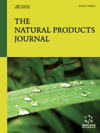- Home
- A-Z Publications
- Natural Products Journal, The
- Previous Issues
- Volume 13, Issue 6, 2023
Natural Products Journal, The - Volume 13, Issue 6, 2023
Volume 13, Issue 6, 2023
-
-
Nigella sativa, a Jack of All Trades Plant in Medicine: Pharmacological Aspects in Diseases Treatment and Prevention
More LessAuthors: Morteza Akhzari, Shiva Mohammadi, Sajad Jalili, Mahdi Barazesh and Karim NoorizadehNigella sativa L. (Ranunculaceae) is one of the most widely used traditional therapeutic plants. It possesses important classes of bioactive compounds, among which thymoquinone, as the major bioactive component of the essential oil, has attracted noteworthy attention due to its active role in treating various disorders. N. sativa can induce a wide range of pharmacological functions, including anti-oxidative stress r Read More
-
-
-
Natural Product Ligands of the Peroxisome Proliferator-Activated Receptor Gamma as Anti-Inflammatory Mediators
More LessImmunologists have long considered inflammation to be a two-edged sword. Short-term inflammation can be beneficial, but long-term chronic inflammation is damaging. Obesity, type 2 diabetes (T2D), and cancer have recently been added to the never-ending list of inflammatory diseases. The nuclear transcription factor peroxisome proliferator-activated receptor gamma (PPAR-γ) is involved in inflammation and obesity. Clin Read More
-
-
-
Significance of Chemically Derivatized Starch as Drug Carrier in Developing Novel Drug Delivery Devices
More LessDelivery of therapeutics using synthetic polymers is challenging due to toxicity, immunogenicity and impaired bioavailability following administration. However, natural polymers are being explored as safe for their use as a substitute for synthetic polymers. In the past three decades, the biomaterials like starches have been applied to impart an imperative role in delivering therapeutics. There is an increased Read More
-
-
-
Assessing Adoption of DNA Barcoding in Herbal Value Chain: A Multistakeholder Analysis
More LessDue to its accuracy and expert-authenticated validation mechanism, DNA barcoding technology is advocated to be superior to existing methods of species identification. While DNA barcoding is generally viewed as valuable innovation in herbal materials authentication, the acceptability and accessibility issues pose a barrier to its uptake into the global herbal regulatory framework. We explore the current status of DNA barco Read More
-
-
-
Pectin/Pectin Derivatives as Potential Scaffolds for the Tissue Engineering Applications
More LessAuthors: Akanksha Pandey, Pramod K. Sharma, Rishabha Malviya and Kalpana RahatePectins are polysaccharides that have a sequence that is similar to that of plant cell membranes that are predominantly made up of galacturonic acid units, and their concentration, morphology, and molecular mass vary. Tissue engineering is a multidisciplinary field that examines natural replacement for the injured tissue to heal or preserve its function, and it involves using scaffolds, cells, and biomolecules. Biocompatible, Read More
-
-
-
Novel Anti-amoebic Properties of Agarophytes Gracilaria changii and Gracilaria salicornia Extracts
More LessAuthors: Tiong-Keat Goh, Yoon-Yen Yow, Ayaz Anwar, Naveed A. Khan and Seng-Kai OngIntroduction: Acanthamoeba is a ubiquitous and parasitic protozoan capable of causing serious human infections, resulting in blindness and even death. Seaweeds are abundant and widely known for their antimicrobial properties. This study aims to unveil the anti-amoebic potential of two Malaysian red seaweeds, Gracilaria changii and Gracilaria salicornia on Acanthamoeba castellanii. Methods: Water, methanol and ethyl Read More
-
-
-
Resveratrol Treatment-induced Nuclear HMGB1 Retention is Critical for Inducing Host Interferon Responses Against Zika Virus
More LessAuthors: Kim-Ling Chin, Nurhafiza Zainal, Sing-Sin Sam and Sazaly Abu BakarBackground: Zika virus (ZIKV) infection is a public health concern and currently there is no specific therapeutic or approved vaccine. Resveratrol (RESV), a natural antiviral compound, has been shown to possess antiviral properties against ZIKV and other viral infections, but the mechanisms of action against ZIKV remain unknown. Objective: This study aimed to investigate the role of the high mobility group box 1 protein (HMGB Read More
-
Most Read This Month
Article
content/journals/npj
Journal
10
5
false
en


